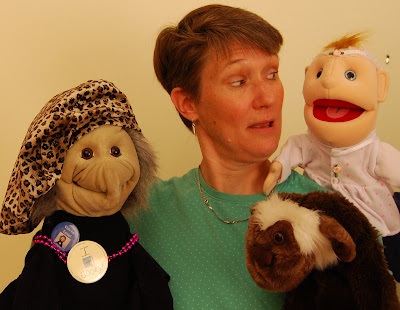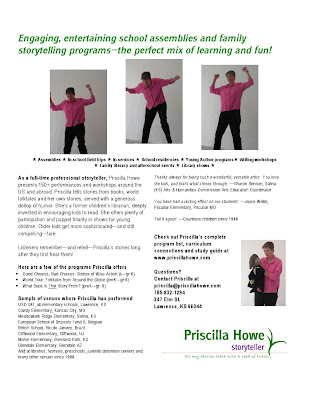
I often give workshops on how to use puppets with children. I teach these tips to participants, with the help of Trixie, the baby and many of my other mouthy handpuppets.
Tips for using puppets
Puppetry is the art of bringing inanimate objects alive. Children do this instinctively, when they pick up an action figure—or a spoon, or a piece of broccoli—and give it voice and movement.
Focus
A large part of making puppets believable comes down to focus: where your puppet is focusing, where the puppeteer is focusing, and where the audience is focusing. Whether you are using a stage or a lap, be sure that your puppet’s eyes look at the audience, not at the ceiling or elsewhere. Have a friend check to see if you are facing the eyes at the audience.
Even if the puppet is speaking to you, have it look at the audience. It will speak, then look at you. If you’re doing a stage show, one puppet speaking to another will still face the audience, then turn to the other puppet. Have the other puppet stay almost still, so it doesn’t distract from the speaking puppet.
If you are in full view of the audience, not behind a stage, when your puppet is speaking, do not make eye contact with the audience. Look at the puppet, draw attention to the character—the audience will not even see the puppeteer, believing totally in the puppet.
Puppet movement
If you’re using a “mouth” puppet, open the mouth on the important words or syllables. Otherwise it looks like your puppet is eating the words. This is counterintuitive so practice until it comes naturally.
Puppet mouths are similar to human mouths: the lower jaw moves down—the head doesn’t move up while speaking. Move your thumb downwards inside the lower jaw of the puppet. This looks more natural. Use your whole hand, wrist and arm to make the movements. Speaking of movement, have your puppet move slightly when it’s on your hand to keep it looking alive. When you remove the puppet, put it down gently. You have created a character: treat it with respect.
Characters
Be consistent when creating characters. Keep the same voice, the same kind of actions for each character. Personality traits and habits are magnified in puppets. For example, if you have a crying puppet, don’t be afraid to have it weep and wail. A sneaky puppet can be extra sneaky, a goofy one can be extra goofy.
Children and puppets
It can be tricky letting kids use puppets for whom you have already created a character. I recommend having puppets for kids to use, but if you let kids use your puppet, it may lose its personality on somebody else’s hand. If you have puppets for children to use, ask them questions about the characters, to encourage them to move through the instinctive hitting and biting stage quickly.
Puppets are powerful. Children may feel more comfortable talking with puppets than with people and may even confide secrets to a puppet. Respect the child’s privacy in this case. Approach children gently with puppets. If a child is scared or shy, move the puppet’s focus away. Never insist that the child engage with a puppet. To make the puppet more approachable, have it mirror a child’s shyness.
Have fun!
© 2009 Priscilla Howe








